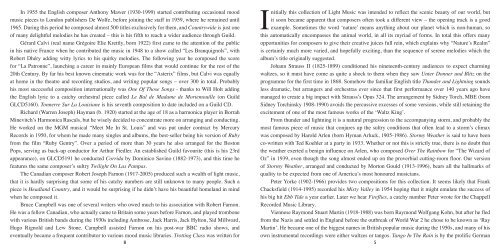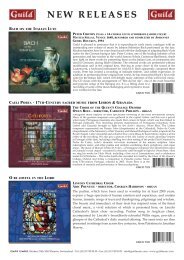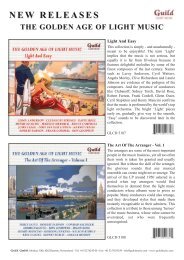Guild GmbH Switzerland
Guild GmbH Switzerland
Guild GmbH Switzerland
Create successful ePaper yourself
Turn your PDF publications into a flip-book with our unique Google optimized e-Paper software.
In 1955 the English composer Anthony Mawer (1930-1999) started contributing occasional mood<br />
music pieces to London publishers De Wolfe, before joining the staff in 1959, where he remained until<br />
1965. During this period he composed almost 500 titles exclusively for them, and Countrywide is just one<br />
of many delightful melodies he has created – this is his fifth to reach a wider audience through <strong>Guild</strong>.<br />
Gérard Calvi (real name Grégoire Elie Krettly, born 1922) first came to the attention of the public<br />
in his native France when he contributed the music in 1948 to a show called “Les Branquignols”, with<br />
Robert Dhéry adding witty lyrics to his quirky melodies. The following year he composed the score<br />
for “La Patronne”, launching a career in mainly European films that would continue for the rest of the<br />
20th Century. By far his best known cinematic work was for the “Asterix” films, but Calvi was equally<br />
at home in the theatre and recording studios, and writing popular songs – over 300 in total. Probably<br />
his most successful composition internationally was One Of Those Songs - thanks to Will Holt adding<br />
the English lyric to a catchy orchestral piece called Le Bal de Madame de Mortemouille (on <strong>Guild</strong><br />
GLCD5160). Tonnerre Sur La Louisiane is his seventh composition to date included on a <strong>Guild</strong> CD.<br />
Richard (Warren Joseph) Hayman (b. 1920) started at the age of 18 as a harmonica player in Borrah<br />
Minevitch’s Harmonica Rascals, but he wisely decided to concentrate more on arranging and conducting.<br />
He worked on the MGM musical “Meet Me In St. Louis” and was put under contract by Mercury<br />
Records in 1950, for whom he made many singles and albums, the best-seller being his version of Ruby<br />
from the film “Ruby Gentry”. Over a period of more than 30 years he also arranged for the Boston<br />
Pops, serving as back-up conductor for Arthur Fiedler. An established <strong>Guild</strong> favourite (this is his 23rd<br />
appearance), on GLCD5191 he conducted Corrida by Dominico Savino (1882-1973), and this time he<br />
features the same composer’s sultry Twilight On Las Pampas.<br />
The Canadian composer Robert Joseph Farnon (1917-2005) produced such a wealth of light music,<br />
that it is hardly surprising that some of his catchy numbers are still unknown to many people. Such a<br />
piece is Headland Country, and it would be surprising if he didn’t have his beautiful homeland in mind<br />
when he composed it.<br />
Bruce Campbell was one of several writers who owed much to his association with Robert Farnon.<br />
He was a fellow Canadian, who actually came to Britain some years before Farnon, and played trombone<br />
with various British bands during the 1930s including Ambrose, Jack Harris, Jack Hylton, Sid Millward,<br />
Hugo Rignold and Lew Stone. Campbell assisted Farnon on his post-war BBC radio shows, and<br />
eventually became a frequent contributor to various mood music libraries. Trotting Class was written for<br />
8<br />
Initially this collection of Light Music was intended to reflect the scenic beauty of our world, but<br />
it soon became apparent that composers often took a different view – the opening track is a good<br />
example. Sometimes the word ‘nature’ means anything about our planet which is non-human, so<br />
this automatically encompasses the animal world, in all its myriad of forms. In total this offers many<br />
opportunities for composers to give their creative juices full rein, which explains why “Nature’s Realm”<br />
is certainly much more varied, and hopefully exciting, than the sequence of serene melodies which the<br />
album’s title originally suggested.<br />
Johann Strauss II (1825-1899) conditioned his nineteenth-century audiences to expect charming<br />
waltzes, so it must have come as quite a shock to them when they saw Unter Donner und Blitz on the<br />
programme for the first time in 1868. Somehow the familiar English title Thunder and Lightning sounds<br />
less dramatic, but arrangers and orchestras ever since that first performance over 140 years ago have<br />
managed to create a big impact with Strauss’s Opus 324. The arrangement by Sidney Torch, MBE (born<br />
Sidney Torchinsky 1908-1990) avoids the percussive excesses of some versions, while still retaining the<br />
excitement of one of the most famous works of the ‘Waltz King’.<br />
From thunder and lightning it is a natural progression to the accompanying storm, and probably the<br />
most famous piece of music that conjures up the sultry conditions that often lead to a storm’s climax<br />
was composed by Harold Arlen (born Hyman Arluck, 1905-1986). Stormy Weather is said to have been<br />
co-written with Ted Koehler at a party in 1933. Whether or not this is strictly true, there is no doubt that<br />
the weather exerted a benign influence on Arlen, who composed Over The Rainbow for “The Wizard of<br />
Oz” in 1939, even though the song almost ended up on the proverbial cutting-room floor. Our version<br />
of Stormy Weather, arranged and conducted by Morton Gould (1913-1996), bears all the hallmarks of<br />
quality to be expected from one of America’s most honoured musicians.<br />
Peter Yorke (1902-1966) provides two compositions for this collection. It seems likely that Frank<br />
Chacksfield (1914-1995) recorded his Misty Valley in 1954 hoping that it might emulate the success of<br />
his big hit Ebb Tide a year earlier. Later we hear Fireflies, a catchy number Peter wrote for the Chappell<br />
Recorded Music Library.<br />
Viennese Raymond Stuart Martin (1918-1988) was born Raymond Wolfgang Kohn, but after he fled<br />
from the Nazis and settled in England before the outbreak of World War 2 he chose to be known as ‘Ray<br />
Martin’. He became one of the biggest names in British popular music during the 1950s, and many of his<br />
own instrumental recordings were either waltzes or tangos. Tango In The Rain is by the prolific German<br />
5
















